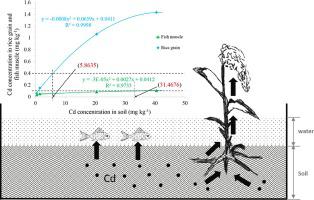当前位置:
X-MOL 学术
›
Environ. Int.
›
论文详情
Our official English website, www.x-mol.net, welcomes your
feedback! (Note: you will need to create a separate account there.)
Effects of cadmium pollution on the safety of rice and fish in a rice-fish coculture system
Environment International ( IF 10.3 ) Pub Date : 2020-07-02 , DOI: 10.1016/j.envint.2020.105898 Wei Luo 1 , Dongjie Wang 1 , Zhou Xu 1 , Guoping Liao 1 , Defang Chen 1 , Xiaoli Huang 1 , Yan Wang 1 , Song Yang 1 , Liulan Zhao 1 , Huagang Huang 2 , Yuliang Li 3 , Wenyan Wei 3 , Yuejin Long 4 , Zongjun Du 1
Environment International ( IF 10.3 ) Pub Date : 2020-07-02 , DOI: 10.1016/j.envint.2020.105898 Wei Luo 1 , Dongjie Wang 1 , Zhou Xu 1 , Guoping Liao 1 , Defang Chen 1 , Xiaoli Huang 1 , Yan Wang 1 , Song Yang 1 , Liulan Zhao 1 , Huagang Huang 2 , Yuliang Li 3 , Wenyan Wei 3 , Yuejin Long 4 , Zongjun Du 1
Affiliation

|
The rice-fish coculture system (RFS) is one of the most important and environmentally friendly agricultural systems in the world. With the increasing amounts of heavy metal contamination in the soil and water, the safe production of RFS has been greatly threatened. However, there are no reports on heavy metal uptake by rice and fish in a RFS. In this study, a model of cadmium (Cd)-contaminated RFS with the addition of 0–40.00 mg kgCd was simulated in the field. The accumulation of Cd in the rice and fish increased as the level of Cd contamination increased. Regardless of the level of contamination, the order of Cd accumulation in the rice was root > stem ≈ leaf > rice grain > brown grain and in the fish was liver ≈ gut > kidney > gill > muscle. The dissolved oxygen (DO) and the transparency of water were significantly reduced after the fish were added. The tendency of the Cd to accumulate in the fish correlated with the change of the concentration of Cd in the water ( < 0.05). According to the maximum level of Cd in the brown grains (0.40 mg kg) and in the fish muscle (0.10 mg kg) of Codex Alimentarius Commission (CAC), the safety threshold of soil Cd for the rice and the fish was calculated to be 5.86 mg kg and 31.47 mg kg, respectively, indicating that the safety risk to the rice was much greater in a Cd-contaminated RFS.
中文翻译:

镉污染对稻鱼共养稻鱼安全的影响
稻鱼共养系统(RFS)是世界上最重要、最环保的农业系统之一。随着土壤和水体重金属污染的日益严重,RFS的安全生产受到极大威胁。然而,没有关于RFS中大米和鱼吸收重金属的报道。在本研究中,现场模拟了添加 0–40.00 mg kgCd 的镉 (Cd) 污染 RFS 模型。随着镉污染程度的增加,稻米和鱼类中镉的累积量也随之增加。无论污染程度如何,稻米中Cd积累顺序为根>茎≈叶>米粒>褐粒,鱼体内Cd积累顺序为肝≈内脏>肾>鳃>肌肉。添加鱼后,水体的溶解氧(DO)和透明度显着降低。 Cd在鱼体内积累的趋势与水中Cd浓度的变化相关(<0.05)。根据食品法典委员会(CAC)棕色谷物(0.40 mg·kg)和鱼肌肉(0.10 mg·kg)中Cd的最大限量,计算出水稻和鱼的土壤Cd安全阈值:分别为 5.86 mg kg 和 31.47 mg kg,表明受 Cd 污染的 RFS 对水稻的安全风险要大得多。
更新日期:2020-07-02
中文翻译:

镉污染对稻鱼共养稻鱼安全的影响
稻鱼共养系统(RFS)是世界上最重要、最环保的农业系统之一。随着土壤和水体重金属污染的日益严重,RFS的安全生产受到极大威胁。然而,没有关于RFS中大米和鱼吸收重金属的报道。在本研究中,现场模拟了添加 0–40.00 mg kgCd 的镉 (Cd) 污染 RFS 模型。随着镉污染程度的增加,稻米和鱼类中镉的累积量也随之增加。无论污染程度如何,稻米中Cd积累顺序为根>茎≈叶>米粒>褐粒,鱼体内Cd积累顺序为肝≈内脏>肾>鳃>肌肉。添加鱼后,水体的溶解氧(DO)和透明度显着降低。 Cd在鱼体内积累的趋势与水中Cd浓度的变化相关(<0.05)。根据食品法典委员会(CAC)棕色谷物(0.40 mg·kg)和鱼肌肉(0.10 mg·kg)中Cd的最大限量,计算出水稻和鱼的土壤Cd安全阈值:分别为 5.86 mg kg 和 31.47 mg kg,表明受 Cd 污染的 RFS 对水稻的安全风险要大得多。











































 京公网安备 11010802027423号
京公网安备 11010802027423号